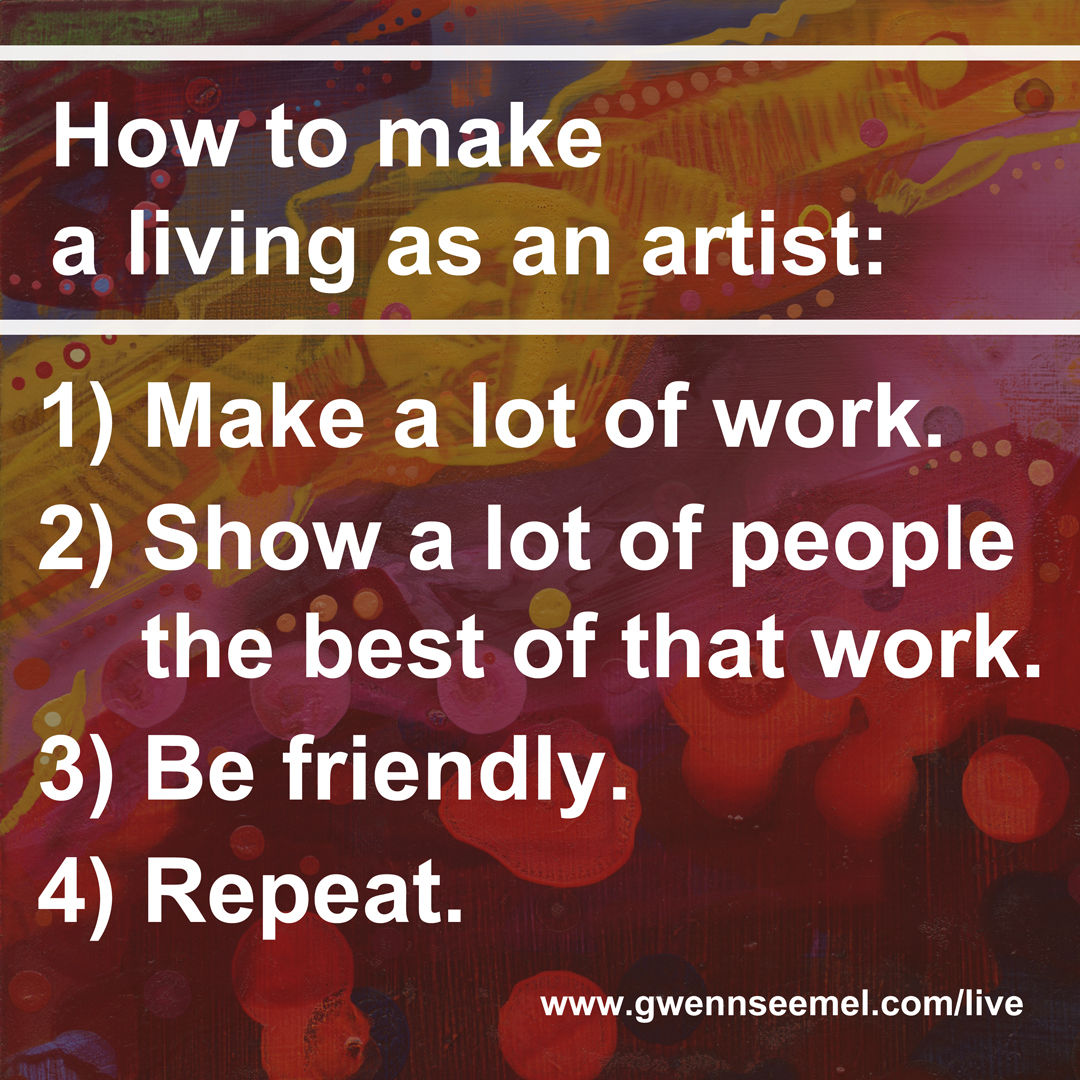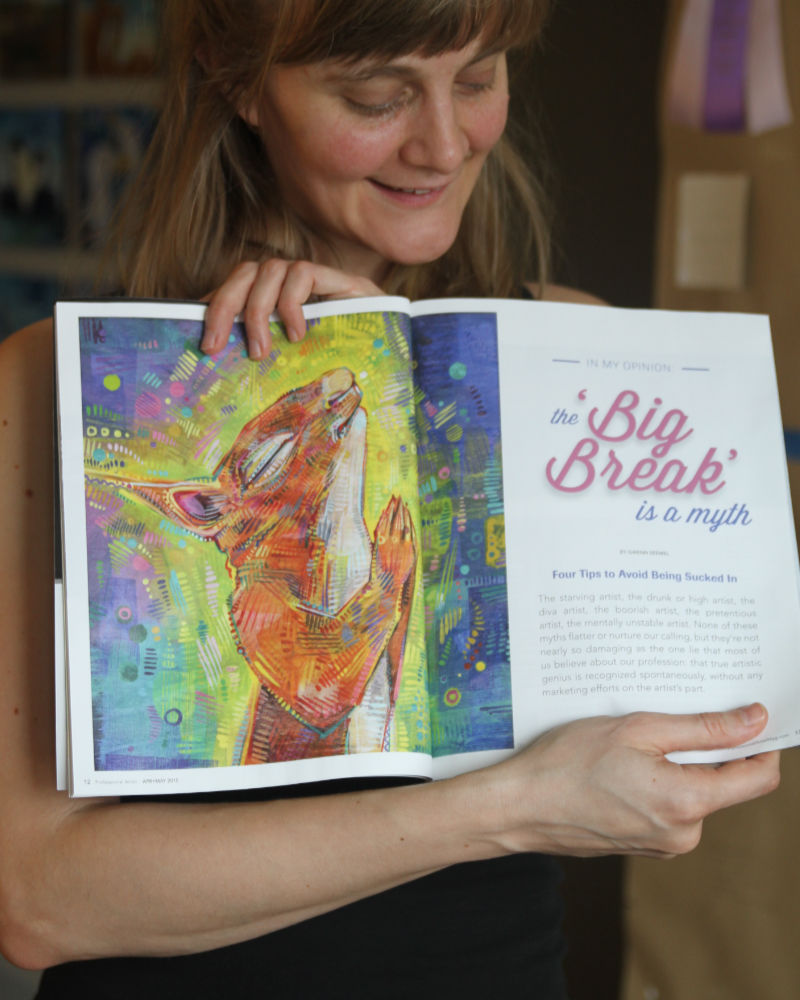Blog / 2015 / How to Make a Living as an Artist
October 10, 2015
I wish I could say that all you have to do to make a living as an artist is to make beautiful work, but that isn’t the case. The fact is that art doesn’t have to be better than mediocre in order to sell. An artwork’s success lies, in large part, in the way it’s perceived and in the context which surrounds the work, which is why making a career as an artist follows the four steps described here.

1. Make a lot of work.
-
Improve your skills.
It may not directly impact your ability to make a living with your art, but it’s still a good thing to pursue as an artist. Creating a lot of work allows you to learn more about your medium and your genre, helping you to get better at what you do. -
Figure out who you are.
An artist’s style develops over time. The more art you make, the more quickly you discover new techniques and iterations on style, helping you to get better at being you. -
Learn to understand your audience.
As you make art, you develop your voice as an artist. You figure out what you really want to communicate only by communicating, missing the mark a bit (either for you or for the audience), and trying again. -
Make art in series.
As you create, conceive of your work in series. This will help you to more fully explore your interests and also to connect with your audience in a new way. When engaging with collections of related artwork, viewers get to immerse themselves more fully in the subject matter.

2. Show the best of that work to a lot of people.
-
Learn to edit.
When you only make three pieces, you’re going to show all three of them, whether or not they’re the best work you can make. When you make twenty, you can easily cut three of the weaker works and still have a whole stack of strong works to show. Of course, this means getting good at editing yourself, but the effort is worth it, because it allows you to be confident in the work that you’re showing. -
Incorporate feedback in a healthy way.
It may be difficult to get an honest critique of your art but seeking out those reactions and really listening to them will allow you to understand what makes your art special and what might make it better. For some artists, asking for feedback will be more complicated than for others, because some artists view art more as self-expression than as communication, but learning to move between these two modes is vital for every creative. -
Document your art properly.
Presenting the best of your art also means only showing your art in the best light. Since artwork is seen mostly in reproduction these days, learning to document your work well is crucial. -
Be professional.
This has nothing to do with how much money you make with your art—or indeed if you make any at all. It’s about the tangible forms that your commitment to your art takes, things like business cards and a website. -
Act with confidence.
More than any other aspect of presentation, your belief in your work will affect how people perceive it. Clients are attracted to the art but they’re also interested in the artist and in supporting the artist’s career in a long term sense. -
Choose your words.
There are multiple ways to frame any conversation, and artists must always be on the lookout for framings that cast them as starving and/or unsuccessful. For example, don’t ever let yourself be tripped up by the questions “where do you show your work?” or “who represents you?” Answer honestly and without apology even if you aren’t partnered with a flashy name-brand gallery. Say “I show in multiple venues and I represent myself.” This won’t impress everybody—because some buyers need artists to be associated with the establishment—but the message will get through to those who are open to it.

3. Be friendly.
-
Get your art seen.
Because art that isn’t out in the world isn’t in any way friendly. - Your platforms. Today, there are plenty of essentially free ways for you to promote your art. Make these social networks and community sites work for you, but don’t overlook the possibility of blogging or publishing a book of your art. However you do it, find some way to love your art publicly and regularly.
- Exhibitions. There’s nothing better than getting your live artwork in front of people. The choice of venue will determine who goes to the show—some people will never set foot in a gallery but they love to be surprised by art in their local coffee shop. Whatever the space, there are a myriad of considerations before you load in a show.
- Openings. While we’re on the subject of showing the work in person, openings seem to be missed opportunities for too many artists. On the audience end of things, it’s disappointing to go to a reception and not have the chance to speak with the artist, but for the artist it’s a shame too. Openings are a great way to reconnect with past clients and meet new people as well as to learn about how well your work is communicating.
- Advertising. It’s not something I choose to pay for, but it can help. For example, early on in my career, I connected with a local theater group which gave me full freedom to create publicity images for their 2004-2005 season. In other words, their marketing budget ended up plastering Portland with my art. They say it takes three hits before a potential customer notices a product consciously, and the theater group helped make the first hit happen for much of the city.
- Press. When someone else talks about your work, it’s a stamp of approval; it is social proof of your identity as an artist. Press releases should be short, but they should also make clear to the journalist that it will be easy to tell a compelling story about your work. For more details about how to write a press release, go to this article. I get into the nitty gritty of getting press in this video.
- Alternative venues. Exhibitions aren’t the only option for getting your work seen. You might participate in charity art auctions (though I don’t), speak at conferences, or apply for grants. That last one will not only earn you some money, but it will also get your art in front of a new audience as the granting body will almost certainly promote the artists it helps.
- Leads. Where to send those press releases? What grants to apply for? A good way to answer these question is by raiding the résumés of all your favorite artists.
-
Keep in touch with clients.
Repeat customers and referrals can be an important source of income for an artist, so nurturing those relationships isn’t just nice, it also makes sense for your business. -
Play with your paywall.
All artists use the paywall to make a living—even those who don’t know what I’m referring to. For more about paywalls, check out this talk about how to free your art which uses examples to really dig into the concept of a paywall. -
Give away art.
It may not seem like the savviest marketing move, but making your art a gift can work wonders. Family and friends are often an artist’s best cheerleaders and giving them something personal to cheer about doesn’t hurt. Doing public giveaways of your art can help bring new interest to your art while also cultivating your connection with longtime supporters. -
Accept donations.
Many artists hate this idea, but the fact is that plenty of people want to support artists but don’t necessarily want more stuff. (I accept donations on Patreon). -
Price your art properly.
The monetary value you assign your art will not only affect who can buy your work but also how your work is viewed. This article gives more details about pricing art. -
Avoid the hard sell.
If you’re really being friendly, you can leave the buying to your clients. You should never have to be so blunt or aggressive as to ask patrons to purchase your work, suggest that it would look great in their homes, or use any number of other sales-y tactics as long as you make sure that people know what you’re up to and who's written about you. -
Protect yourself.
Being friendly isn’t the same as being a chump. This video explains some of the scammy stuff that happens, and this article gives pointers about taking someone to small claims court. Of course, those posts only scratch the surface of this topic. The fact is that artists are ripe for the rip-off, because most of us were raised to believe that creatives either don’t make money or that they shouldn’t. Some of us were even told that artists are worthless individuals! In other words, some part of us thinks we deserve no better, but we absolutely do. (I didn’t recognize the way these negative associations play into artists being duped until I ran across this excellent Tumblr post.) -
Sign contracts.
Written agreements are a part of inspiring confidence in clients: it lets them know that you value your work and your career. Since I’d never ask someone to sign a contract full of legalese, I’ve written my own sales agreement and model release. -
Do commission work only if you’re prepared for the challenge.
Either love it and embrace all of its complexities or avoid working with clients in this way. Learning to set up good boundaries with patrons can help you to love commission work. -
Put your art in the public domain.
The friendliest thing an artist can do is to release their art from the constraints of copyright, but, even if you’re not ready to go all the way by renouncing your copyright entirely, there’s lots of room to improve over the traditional copyright via Creative Commons licenses. The fact is that your copyright makes it illegal for people to share your art on social media without asking you first, a demand that is as damaging to your career as it is to creativity.

4. Repeat.
-
Persevere.
The difference between the people we know as artists today and the people whose work has been forgotten is not talent: it’s hard work and persistence. The artists are the ones who didn’t give up. -
Recognize your weaknesses and find ways around them.
A lot of artists have the passion and the work ethic to succeed, but they’re bad at some other part of art business. Maybe they can’t freelance to save their lives or maybe they’re painfully shy. Whatever it is, acknowledging the problem and dealing with it are essential. -
Embrace rejection.
Because, if you want to make a living as an artist, you’re going to need to get used to hearing “no” or, worse still, not hearing anything at all. I’m constantly applying to venues, grants, and, in a sense, prospective clients, which means that I’m always making myself vulnerable. It isn’t fun. This is how I deal. -
Own your successes.
None of us makes it on our own and acknowledging those who’ve helped us is a good idea. That said, a sure way to end up flailing is by failing to take the reins when opportunities come our way. If you don’t figure out how to make those lucky breaks really yours, you might end up twiddling your thumbs while waiting for the next one and lose any desire to keep creating.

Making money from your art makes you a better artist. That’s not to say that the fact of making money from your art automatically means that your art is better. Rather, the act of making a living (or part of a living) while doing what you love will help you to invest in it more fully. After all, if making art makes you money, you will probably make more time for it. What’s more, when people are willing to spend their hard earned money on your art, it can’t help but build your confidence. This means you will be in a better place emotionally when it comes to criticism of your art, and that will ultimately help you to make better art.
You can download my e-book about art marketing, and, if you’re interested in the concept of uncopyrighting, check out my book about copyright.
You can also hire me as your art guide.
Maybe this post made you think of something you want to share with me? Or perhaps you have a question about my art? I’d love to hear from you!
To receive an email every time I publish a new article or video, sign up for my special mailing list.
If you enjoyed this post, Ko-fi allows you to donate. Every dollar you give is worth a bajillion to me!



